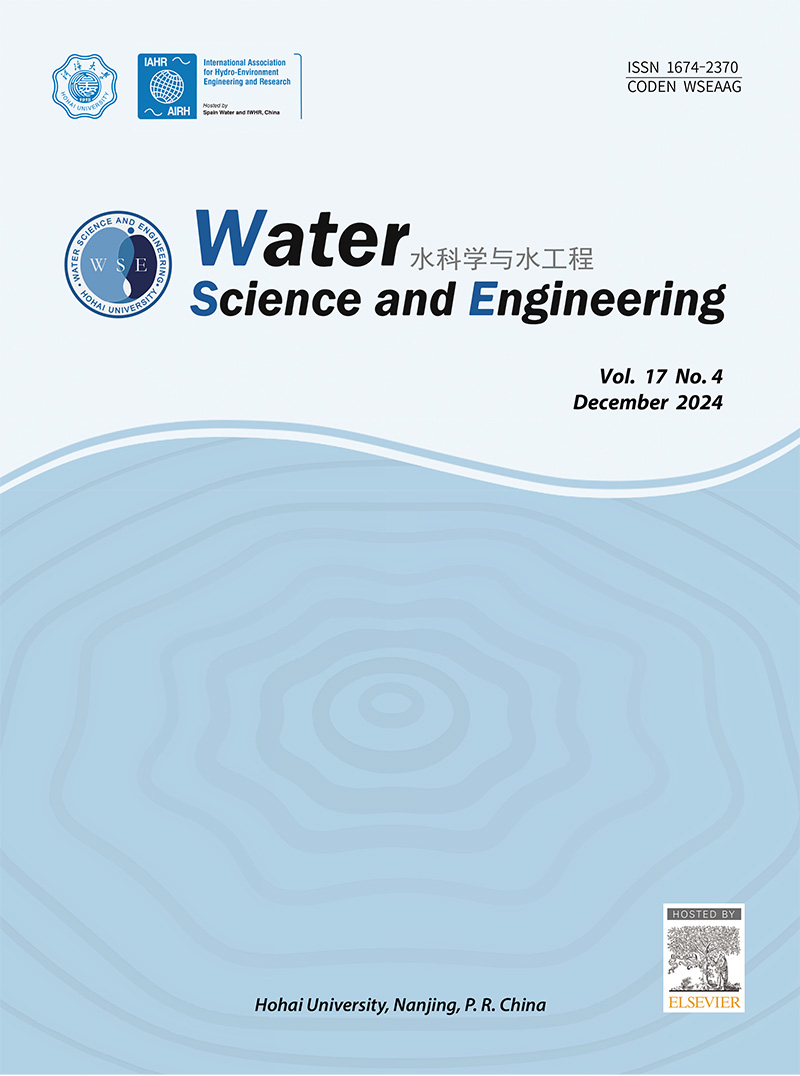Hydraulic performance assessment of various submerged pile designs around an emerged dike
IF 4.3
Q1 WATER RESOURCES
引用次数: 0
Abstract
This study aimed to devise strategies for alleviating the detrimental impacts of floods in the vicinity of a dike. Experiments were conducted in an open rectangular channel to investigate the flow dynamics under varying dike conditions. To address concerns related to intense whirls and concentrated flow around the dike head, comparative analysis was performed in terms of flow structures and energy reduction around I-shaped and T-shaped dikes with two ratios of wing length (lw) to dike length (ld) (lw/ld = 1.41 and 2.43). The T-shaped dike wings were equipped with diverse designs: angled footing, delta vane, and streamlined tapered, resulting in elevated backwater in front of the dike, reduced velocity, and enhanced energy reduction. The findings indicated that elongating the wing reciprocally affected the depth-averaged velocity (at the dike head and near the adjacent dike bank), concurrently impacting flow deflection, backwater rise, and energy reduction rate. The T-shaped dike, specifically with an angled footing (lw/ld = 2.43), yielded optimal outcomes. These included significant reductions in maximum energy (46%), tip velocity (98%), and dike adjacent bank velocity (90%), as well as significant flow deflection towards the mainstream, outperforming the I-shaped impermeable dike. The proposed solutions exhibit efficacy in mitigating rapid deterioration during floods, securing both the dike head and the neighboring bank to avert failures in high-energy flow.
出露堤坝周围各种水下桩设计的水力性能评估
本研究旨在制定减轻堤坝附近洪水有害影响的策略。实验在一个开放的矩形水道中进行,以研究不同堤坝条件下的水流动力学。为了解决与堤坝头部周围的强烈漩涡和集中流有关的问题,对 I 形和 T 形堤坝周围的流动结构和能量减少情况进行了比较分析,这两种堤坝的翼长(ld)与堤坝长度(ld)之比分别为 lw/ld = 1.41 和 2.43。T 形堤翼采用了不同的设计:斜脚、三角叶片和流线型锥形,从而提高了堤前的回水位,降低了流速,增强了减能效果。研究结果表明,拉长翼片会对深度平均流速(堤坝头部和邻近堤岸附近)产生相互影响,同时对水流偏转、回水上升和能量减少率产生影响。T 形堤坝,特别是带有倾斜基脚(lw/ld = 2.43)的堤坝,产生了最佳效果。这包括最大能量(46%)、顶端流速(98%)和堤岸邻岸流速(90%)的显著降低,以及流向主流的显著偏转,优于 I 型防渗堤。所提出的解决方案可有效缓解洪水期间的快速恶化,确保堤顶和邻近堤岸的安全,避免在高能量水流中发生溃堤。
本文章由计算机程序翻译,如有差异,请以英文原文为准。
求助全文
约1分钟内获得全文
求助全文
来源期刊

Water science and engineering
WATER RESOURCES-
CiteScore
6.60
自引率
5.00%
发文量
573
审稿时长
50 weeks
期刊介绍:
Water Science and Engineering journal is an international, peer-reviewed research publication covering new concepts, theories, methods, and techniques related to water issues. The journal aims to publish research that helps advance the theoretical and practical understanding of water resources, aquatic environment, aquatic ecology, and water engineering, with emphases placed on the innovation and applicability of science and technology in large-scale hydropower project construction, large river and lake regulation, inter-basin water transfer, hydroelectric energy development, ecological restoration, the development of new materials, and sustainable utilization of water resources.
 求助内容:
求助内容: 应助结果提醒方式:
应助结果提醒方式:


